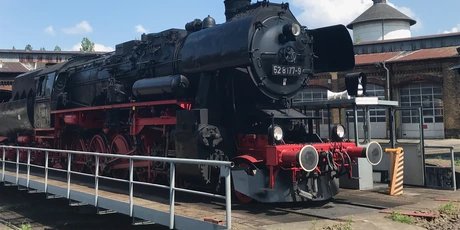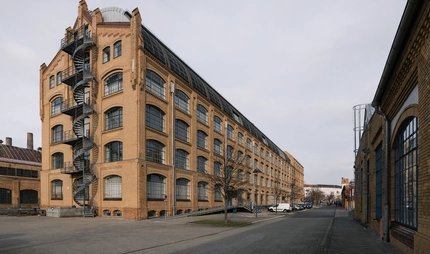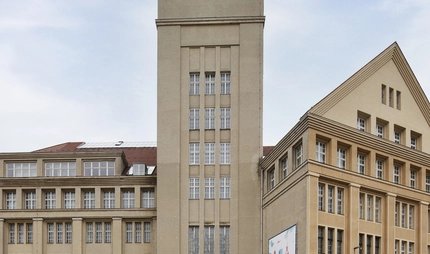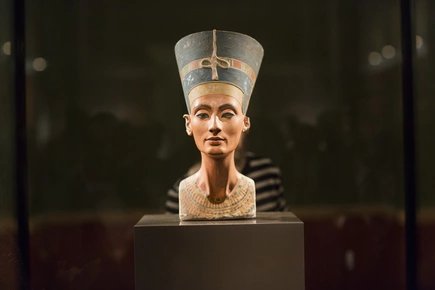
Steam locomotives at the Schöneweide railway depot
Full steam ahead into the future
Where the Reichsbahn used to repair steam locomotives, today a multi-purpose site is being created in a historic setting.
A loud hissing sound, a white cloud of steam and the huge, black and red locomotive rattles into motion.
Although most people travel by electric train today, steam-powered railways continue to exert a strong fascination: the sounds, the technology, the strenuous work - all of this contributes to the myth of the steam locomotive.
In Niederschöneweide, you will find Berlin's only completely preserved railway depot. Here, the members of the Dampflokfreunde Berlin e.V. association maintain historic steam locomotives and carriages. They also offer visitors the chance to take part in a historical train ride. A visit to the site gives you the unique opportunity to immerse yourself in a piece of living industrial history.
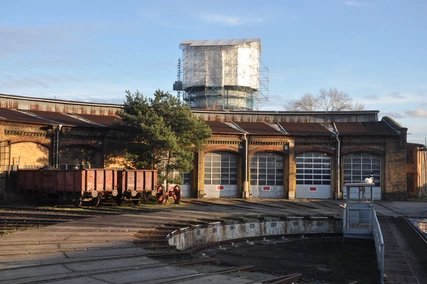
The creation of a travel hub
Two years after the Berlin-Cottbus railway line opened, the "Neuer Krug" stop at today's Berlin-Schöneweide station was built in 1868. A marshalling yard is built to the east of it, where wagons are attached to locomotives and assembled into trains.
Over the next few decades, traffic continues to grow, increasing fivefold by 1904. The construction of a new railway depot for the maintenance and repair of locomotives and railcars is urgently needed. To this end, the marshalling yard was extended and rebuilt from 1902, and the Schöneweide depot went into operation in 1906.
It had supra-regional significance: from now on, wagons from different directions met here. The station ensured supplies to industry and served as a travel hub. The Schöneweide marshalling yard was in operation for almost 100 years before Deutsche Bahn AG finally closed it in 1998.
The Dampflokfreunde Berlin e.V. association has been active since the mid-1990s.
Architecture of the site
When visiting the Schöneweide depot, it is still the architectural highlight of the site today: the semi-circular roundhouse, which can accommodate up to 20 locomotives at maximum capacity. When the depot opened, it originally only had 12 locomotive stands. Due to the high volume of traffic, extensions were added in 1908 and 1913 to reach the current number of 20 stands.
- The ring locomotive shed is clad in yellow clinker bricks, the arched gate openings on the inside are set off by reddish-brown bricks.
- A 23 m long turntable is installed in front of the roundhouse. It enables the locomotives stored in the shed to be distributed to the star-shaped tracks.
- The historic water tower from 1906 is still visible from afar. When the station was in active use, it contained fresh water for the locomotives' steam boilers. A tower shaft clad in red bricks supports the protruding water tank with a capacity of 250 cubic metres of water. The tower is topped by a protruding, conical roof with a small ridge turret. After a two-year renovation, the water tank will shine in new splendour in 2021.
In addition to the railway facilities, there are other buildings on the four-hectare site: for example, the clinker-clad service building with a half-timbered gable, the medical building and the two-storey, clearly structured accommodation building.
Verein Dampflokfreunde Berlin
The "Dampflokfreunde Berlin e. V." association is an association of former railway enthusiasts and railway fans that has been active on the site of the Schöneweide depot since 1991. The association has managed to save a total of five historic locomotives from being scrapped and restore them to working order.
The centrepiece of the collection is "Else", a freight steam locomotive from Potsdam, built in 1944. Officially designated as locomotive number 52 8177, it was originally intended as a war locomotive for the eastern campaigns. Later, it pulled heavy goods trains instead.
In 1992, the Deutsche Reichsbahn made plans to scrap Else. Several locomotive drivers joined forces and prevented this from happening, and since then she has been a 1600 hp locomotive for the Dampflokfreunde.
Permanent loans from the DB Museum Nuremberg are also part of the association's collection, including a diesel locomotive built in Romania and the carriages of a historic express train.
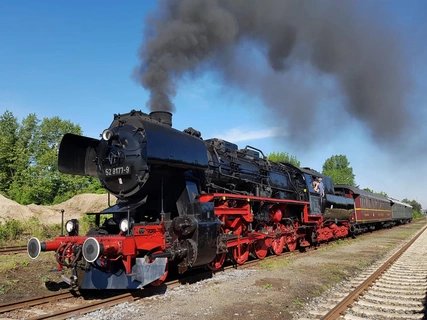
Technology of steam locomotives
In principle, the technology of a steam locomotive like "Else" works in exactly the same way as it has since the early days of railway travel in the 19th century: Coals fan a fire, which in turn provides steam in the boiler. The 16 bar of pressure generated is passed on to the gearbox as power.
However, to ensure that everything runs properly and safely, Else and the other locomotives in the association have to undergo a general inspection every 8 years. Are all the plates and bolts tight, is the pressure in the boiler correct? The inspection is extensive - and expensive, which is why the association relies on donations. In addition, the Steam Locomotive Friends raise the necessary money through their numerous offers for visitors.
Offers from the "Dampflokfreunde Berlin"
Two times a year, the association invites technology enthusiasts, steam locomotive fans and families to large festivals: the Spring Festival and the Railway Festival. On this occasion, all visitors can explore the over 100-year-old industrial site. Guided tours also take place once a month during the open day.
You can experience for yourself what it's like to travel on a historic steam locomotive on one of the regular nostalgia trips. Destinations include Dresden, the Harz Mountains and Warnemünde.
Berlin city tour in historic trains
The differences in class are noticeable in the comfort: from the hard benches of "wooden class" to the soft seat cushions of 1st class, everything is included. The sightseeing tours on the Ringbahn, where even locals learn something new about Berlin, are also very popular.
A special highlight:
- The journey in the Mitropa dining car from the 1930s. Between leather-upholstered seats and crystal partitions, you'll get a real Orient Express feeling.
The Ringlokschuppen also regularly hosts cultural events: the historic industrial building provides an atmospheric backdrop for theatre productions, readings, concerts and private parties.
To book nostalgia trips and find out more about events on the premises, visit the association's website: www.berlin-macht-dampf.com
Future of the site
The renovation of the water tower is just the beginning of the extensive construction work on the Schöneweide depot site. The restoration and renovation of the roundhouse in line with its listed status is also planned for the coming years.
After conversion and renovation, the service and accommodation building will also be usable in future. In addition to seminar rooms for the international youth building lodge, the voluntary social year in the field of crafts and monument preservation, there will also be overnight accommodation for graduates.
New rooms for youth and school groups will also be created in the overnight accommodation building, which was previously used as overnight accommodation for train drivers. There are also plans to allow overnight stays in two historic sleeping carriages.
In the outdoor area, the "Forum am Wasserturm" with terrace and café is planned, among other things. Here you can relax in future and enjoy the very special atmosphere of this living industrial monument.
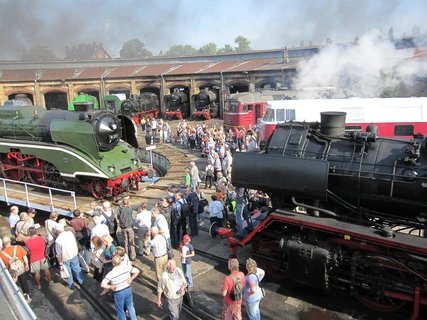
Our tips around the Schöneweide depot
- Kabelwerk Oberspree KWO
More industrial architecture can be found in Oberschöneweide, on the other side of the Spree. The imposing building of the Kabelwerk Oberspree is definitely worth a visit. From the Johannisthal stop, take the S-Bahn line S8, S9, S45 or S46 for one stop to Schöneweide S-Bahn station. From there, take tram line 27, 60 or 67 for four stops to the Rathenaustraße/HTW stop. Then walk another 80 metres to Wilhelminenhofstraße 76.
- Peter Behrens Bau
Only 450 metres away from Kabelwerk Oberspree, at Ostendstraße 1-4, you will find the Peter-Behrens-Bau, which is closely linked to the history of the automotive industry in Berlin.
- Industriesalon Schöneweide
Round off your walk through industrial history with a visit to the Industriesalon Schöneweide at Reinbeckstraße 9. Here you can find out more about the history of Schöneweide, once an important industrial centre. Take tram line 27, 60, 61 or 67 to the Firlstraße stop. From here, you can walk 450 metres to the Industriesalon Café Schöneweile right next door serves coffee, cake and bagels
Practical information from visitBerlin
To the Schöneweide railway station, take S-Bahn line 9 or 45 in the direction of Berlin-Schönefeld Airport or S-Bahn line 46 in the direction of Königs Wusterhausen. Get off at the Johannisthal stop and use the bridge over the railway tracks to get to the Schöneweide railway depot.
To explore the city, we recommend the Berlin WelcomeCard for local public transport.
